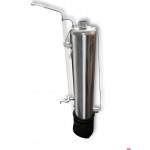
How to Use a Household Autoclave: Instructions from Uteho
How does an autoclave work?
Instructions
.png)
Products for Autoclaving:
Watch the Video:
Autoclave Instructions
Autoclave — not only a device for safe preservation but also an excellent kitchen assistant that makes the process of preparing homemade canned goods quick and convenient.
The instructions for the autoclave are relevant if you decide to use a household autoclave for canning. Watch the video or read the article below, where we discuss the main steps of using the autoclave. This information will help you easily master the basics of using an autoclave and see that it is actually very simple to operate.
First of all, it is worth familiarizing yourself with the main parts of the autoclave to understand how it works.
Main components of the autoclave
- Body: Made of stainless food-grade steel or black metal, depending on the model.
- Handles: For convenient transportation.
- Pressing lid with bolt clamps: Ensures a tight seal on the autoclave.
- Manometer: To monitor pressure.
- Thermometer: To monitor temperature.
- Safety valve: Provides protection.
- Nipple and ball valve: Used for pressure regulation.
- Heating element (TEN): For electric models.
- Jar stands: Allow for proper placement of containers inside the autoclave.
- Drain valve: For convenient water drainage.
- Control unit: Only for electric models, consisting of a thermostat and temperature sensor.
Preparation for Use
- Loading the products: Pre-prepared products are loaded into jars or retort pouches, which are then evenly placed on the stands inside the autoclave.
- Adding water: Pour room temperature water, which should cover the jars by 2 cm above.
- Closing the lid: Tighten the pressing bolts crosswise to avoid misalignment.
.png)
When should initial pressure be created?
.png)
Preserving Process
- within 3.5–4.5 atmospheres if initial pressure was created;
- within 1.7–2.5 atmospheres — without initial pressure.
.png)
Cooling and Opening the Autoclave
- For jars with standard SKO lids and retort pouches, the autoclave should only be opened when the temperature drops to 30°C.
- For euro jars with twist-off lids, opening is allowed at 60–70°C.
.png)
Safety!
- Do not touch the hot surfaces of the device.
- Do not open clamps and valves while the autoclave is operating.
- Do not release pressure earlier than required by the temperature conditions, depending on the container you are using for preservation.
.png)
Finishing the Process
.png)
Avoid autoclaving problems by following our tips!
Using a household autoclave is easy! And if you still have questions, you can always refer to the "Frequently Asked Questions" section or leave a comment. Thank you for your attention, and enjoy preserving with Uteho!
22.08.2024

Uteho
Don’t forget to subscribe to our channel so you don’t miss new interesting videos, get useful tips on autoclaving, and discover exciting recipes for the autoclave.









-250x250.webp)



